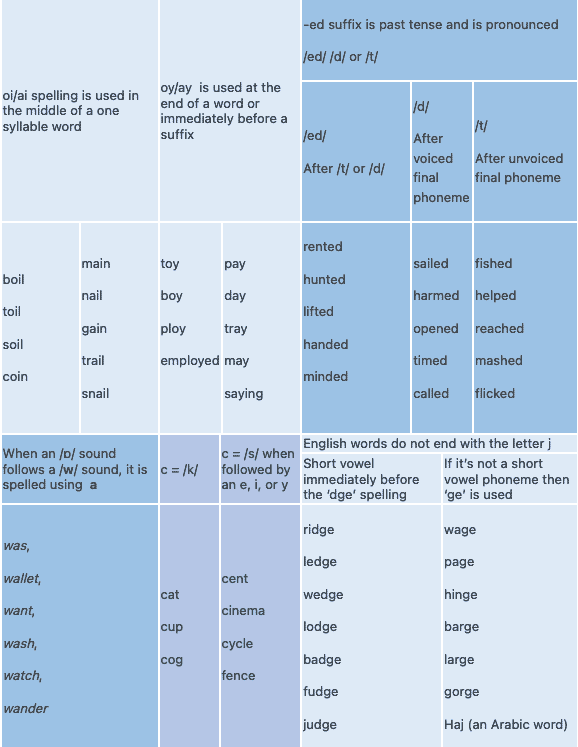Spelling rules: are they a help or a hindrance when learning to read?
Home » Phonics » Essential principles of systematic and explicit phonics instruction » Spelling rules: are they a help or a hindrance when learning to read?
To ‘e’ or not to ‘e’ – should you teach “bossy -e” and other spelling rules?
Does your school use spelling rules to teach students about reading and spelling? Do spelling rules simplify or complicate the learning of English orthography?
Teachers traditionally have relied on spelling rules to try to help learners to memorise words for rapid retrieval. These rules have become the subject of debate as to whether they are confusing or contain too many exceptions. Consider the common spelling rule ‘when two vowels go walking, the first one does the talking’. This works for boat, beat, pie, and mail, but it doesn’t work for boil, steak, vein or build.
Another common rule is ‘magic -e’, also called ‘bossy -e’, ‘silent -e, or even ‘ninja -e’. All of these names are referring to a split vowel digraph.
Without a deep understanding of what to teach and why, teachers can only state “that’s an exception to the rule”. When there are too many exceptions, it can become confusing. Furthermore, students who have limited working memory or are learning English as a Second Language may find lengthy verbal explanations of rules overwhelming.
Although the English writing system is complex, it is more logical than many people think, and a well-informed teacher who has knowledge of phonology, origins of words, the meaning of morphemes and how to combine grapheme-phoneme correspondences within a word, can explain the logic and patterns of English and help students to build efficient orthographic mapping and reduce confusion.
The critical word is patterns. Patterns represent a guide, whereas rules represent a law that cannot be violated. According to Mark Seidenberg (2017) and others, the English system is not so much rule governed as statistical — some spellings are much more common than others. The split vowel digraph merely represents a very common spelling pattern. English is full of relatively predictable patterns and Louisa Moats (2010) highlights the following statistics:
- 50% of English words are spelled accurately by sound-symbol correspondence rule alone
- 36% more are spelled with only one error
- 10% more are spelled accurately if word meaning, origin and morphology are considered
- Fewer than 4% are true oddities
Explicit instruction and repeated exposure to the targeted phonemes and patterns via carefully selected phoneme-grapheme mapping exercises and carefully selected word banks is essential to developing knowledge of how words are pronounced and spelled.
Tips for teaching
If all the phonemes in English could be represented by one letter, teaching of reading and spelling would be simpler. It is essential that students move beyond simple single letter grapheme-phoneme correspondences and broaden their knowledge (see Moats, 1998).
Phonemes can be represented by more than one grapheme, for example a can be represented by a, ai, ay, ea, a-e, eight and a single grapheme can represent several phonemes. For example the ea grapheme can be used for three phonemes eat, steak, bread.
Explicitly teaching grapheme-phoneme correspondences means teaching readers that some graphemes represent more than one phoneme (s/z and c/s, g/j), and a single phoneme can be represented by more than one grapheme (a, a-e, ai, ay, eigh, and so on). Students need to also understand that some graphemes choices are influenced by such things as its position in a word (oi / oy), (dge / ge), or the surrounding phonemes.
When early readers are encouraged to sound out words, they pair the sound of the word with its visual representation. This builds knowledge of grapheme-phoneme correspondences and ‘legal and illegal’ placement in English words. Eg; the gh in ‘rough’ represents the /f/ phoneme and it never appears at the beginning of a word.
Repeated exposure to the patterns of English using carefully selected decodable texts containing the targeted grapheme-phoneme correspondences is essential for building letter-sound skills for automatic recognition. Readers are gaining an understanding of English spelling patterns and fine tuning these each time they are exposed to text. Learners will need to practice hearing the words, seeing the words and writing the words for them to be permanently stored or ‘mapped’ and ready for automatic retrieval.
The program or pedagogy that you have in place at your school will determine how you approach reading and spelling. It should allow ample practice of letter-sound associations, build phonemic awareness to an advanced level, and provide opportunities for learners to match phonemes to graphemes in words for automatic retrieval.
Grouping words into lists that have clear and logical grapho-phonological relationships allows early learners to build and internalise important knowledge of English orthography.
Knowledge of spelling conventions including the split vowel digraph are helpful for creating a ‘map’ between oral phonemes and the letter sequences in a word. If you choose to use a term like silent-e or magic-e, the language used should be consistent across all grades so that students aren’t confused by a variety of terms and approaches.
A knowledgeable teacher can help to simplify the learning of the English code. This helps students to quickly and efficiently grasp the patterns of the language and gives them resources for self-teaching to emerge once sufficient phoneme grapheme knowledge has been learned. Some students may work these patterns out for themselves, but many will require explicit teaching to crack the code.

